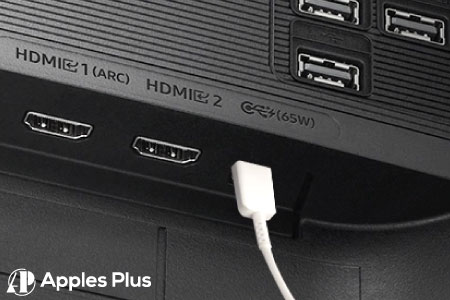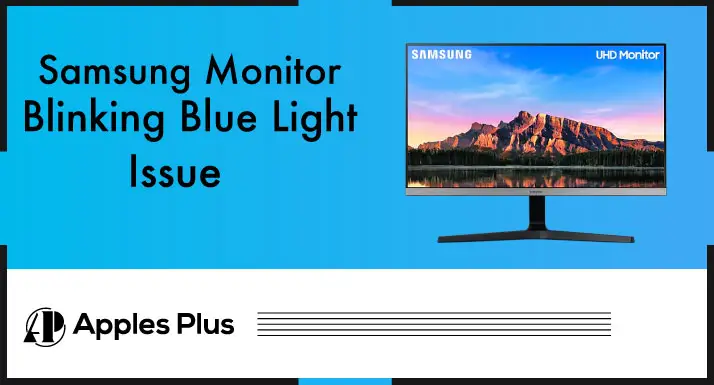Samsung monitors are known for their high-quality displays and reliability, but like any electronic device, they can experience issues from time to time.
A blinking blue light is one of the most common issues reported by Samsung monitor users. It can be a frustrating problem to deal with, as it can indicate a range of issues, from loose cable connections to graphics card problems.
In this blog post, we will explore the different causes of a Samsung monitor blinking blue light and provide possible solutions to help you troubleshoot and fix the problem.
Why My Samsung Monitor Blinking Blue Light?
A blinking blue light on a Samsung monitor usually indicates that the monitor is not receiving a signal from the computer or other connected device. Here are a few possible reasons and solutions:
1. Loose Cable Connections:
Loose cable connections can be a common reason for a monitor to display a blinking blue light, indicating that it is not receiving a signal from the computer or other connected device.
A loose cable connection can cause signal interruptions or a complete loss of connection, resulting in the monitor’s blue light blinking. Here are a few things to keep in mind when dealing with loose cable connections:

- When checking for loose cable connections, inspect both ends of the cable – the end connected to the monitor and the end connected to the computer or other device. Check for any visible damage, such as bent or broken pins, which can affect the connection.
- If the cable appears undamaged, ensure it is securely plugged into the monitor, computer, or another device. Some cables require a little extra pressure to sit in the ports fully, so try gently push the cable to ensure it is fully inserted.
- If the cable still seems loose or damaged, try replacing it with a new one. Sometimes cables can wear out over time or become damaged through use, so using a new cable can help to ensure a secure connection.
- Longer cables are more prone to signal loss and interference, so use a shorter cable if possible. If you need to use a longer cable, ensure that it is of high quality and specifically designed for your device.
By taking these steps, you can ensure that your monitor’s cable connections are secure and that you receive a stable signal from your computer or another device.
2. Faulty Cables:
Faulty cables can be another reason a Samsung monitor might display a blinking blue light. Faulty cables can cause signal interruptions or a complete loss of connection, resulting in the monitor’s blue light blinking. Here are a few things to keep in mind when dealing with faulty cables:
- Inspect the cable for any visible signs of damage, such as frayed or damaged insulation, bent or broken pins, or loose connectors. Damage to the cable can cause signal interference or a complete loss of signal.
- If you suspect the cable may be faulty, test it with another device, such as a different monitor or TV. If the cable works fine with the other device, the problem may be with the original monitor or the computer itself. If the cable doesn’t work with the other device, then it’s likely that the cable is faulty.
- If you have determined that the cable is faulty, then replacing it with a high-quality cable is essential. Look for a cable specifically designed for your device, and check the length and type of cable needed. A poor-quality cable may cause signal interference or other problems, so it’s worth investing in a good-quality replacement.
- Depending on the type of connection needed, it may be worth considering using a different cable. For example, if you use a VGA cable, it may be worth trying an HDMI or DVI cable instead to see if that resolves the issue.
By following these steps, you can ensure that your Samsung monitor receives a stable signal from your computer or other device and that any issues related to faulty cables are resolved.
3. Incorrect Input Settings:
Another reason a Samsung monitor may display a blinking blue light is incorrect input settings. It means that the monitor is not set to the correct input source to receive a signal from its connected device. Here are a few things to keep in mind when dealing with incorrect input settings:

- Most monitors have multiple input sources, such as VGA, HDMI, DVI, and DisplayPort. Ensure the monitor is set to the correct input source for its connected device. Some monitors have an auto-detect feature that automatically detects the input source, but checking is still a good idea.
- Most monitors have a menu system that can be accessed using the buttons on the monitor or remote control. Use the menu system to select the correct input source. Consult the monitor’s user manual if you need help accessing the menu.
- Sometimes, the issue may be with the monitor’s device rather than the monitor itself. Check the device’s output settings to ensure it is set to output to the correct port and at the correct resolution.
- Try using a different cable if you’ve checked the input source and output settings and still have issues. A faulty cable can cause signal loss and other problems, so it’s worth ruling out a cable issue.
By following these steps, you can help ensure that your Samsung monitor is set to the correct input source and receives a stable signal from your device. You can move toward the next step if you’re still having issues.
4. Graphics Card Issues:
Graphics card issues can be another reason why a Samsung monitor may display a blinking blue light. The graphics card is responsible for sending the video signal to the monitor.
So if there are issues with the graphics card, it can cause problems with the monitor’s display. Here are a few things to keep in mind when dealing with graphics card issues:
- Make sure that the graphics card drivers are up to date. Outdated drivers can cause various issues, including monitor display problems. Check the manufacturer’s website for the latest drivers and follow the installation instructions carefully.
- Inspect the graphics card for any visible signs of damage, such as bent or broken pins, loose components, or signs of overheating. If the graphics card is damaged, it may need to be replaced.
- Make sure that the graphics card is set up correctly. Check the graphics card’s control panel or software to ensure it is set to the monitor’s correct resolution and refresh rate. If the settings are incorrect, it can cause problems with the monitor’s display.
- If you can access a different graphics card, swap it out and see if that resolves the issue. If the other graphics card works fine, the problem is likely with the original graphics card and may need replacing.
By following these steps, you can help identify and resolve any graphics card issues that may be causing problems with your Samsung monitor.
If you’re still having issues, it need to contact the customer support or a technical person near you.
Conclusion
In conclusion, a Samsung monitor blinking blue light can be caused by various factors, including loose cable connections, faulty cables, incorrect input settings, and graphics card issues.
You can identify and resolve the issue with your Samsung monitor by following the troubleshooting steps outlined for each of these causes. It’s always a good idea to consult the monitor’s user manual or contact Samsung customer support if you need help with how to proceed.
By taking the time to diagnose and fix the issue with your monitor, you can ensure that it continues to provide you with a high-quality display for years to come.

Meet Harry, the author of Apples Plus! Harry is a highly skilled electronic engineer passionate about testing and reviewing tech products like monitors and soundbars. With years of experience in the industry, Harry has developed a keen eye for detail and an in-depth understanding of the latest tech trends and developments.


